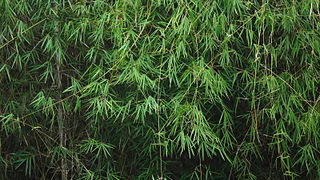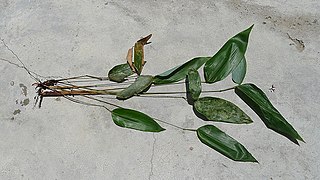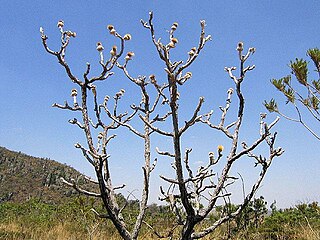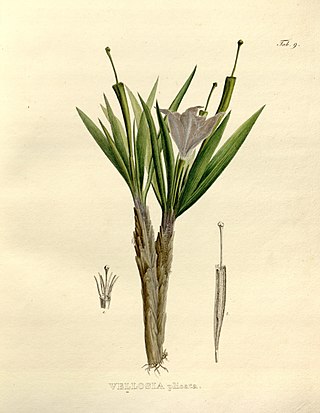
Chrysophyllum is a group of trees in the Sapotaceae described as a genus by Linnaeus in 1753.

Atractantha is a South American genus of bamboo in the grass family, native to Brazil, Colombia, and Venezuela.
- Atractantha amazonicaJudz. & L.G.Clark - Amazonas in Brazil, Amazonas in Venezuela, Vaupés in Colombia
- Atractantha aureolanataJudz. - Espírito Santo, Bahia
- Atractantha cardinalisJudz. - Bahia
- Atractantha falcataMcClure - Bahia
- Atractantha radiataMcClure - Bahia
- Atractantha shepherdiana – Athroostachys shepherdiana

Pouteria is a genus of flowering trees in the gutta-percha family, Sapotaceae. The genus is widespread throughout the tropical Americas, with outlier species in Cameroon and Malesia. It includes the canistel, the mamey sapote, and the lucuma. Commonly, this genus is known as pouteria trees, or in some cases, eggfruits.

Velloziaceae is a family of monocotyledonous flowering plants. The APG II system, of 2003, also recognizes this family, and assigns it to the order Pandanales.

Myrciaria is a genus of large shrubs and small trees described as a genus in 1856. It is native to Central and South America, Mexico, and the West Indies, with many of the species endemic to Brazil. Common names include hivapuru, sabará, and ybapuru.

Dichorisandra is a genus of perennial monocotyledonous flowering plants in the dayflower family (Commelinaceae). It is found in the Neotropics. The genus is characterised by its slightly zygomorphic flowers with large anthers usually releasing pollen by means of pores at the apex, as well as by its seeds that are embedded in a red or sometimes white aril, and tubers that often form at the tips of the roots. Both morphology and an analysis of DNA sequences indicate it is very closely related to the genus Siderasis.

Vriesea is a genus of flowering plants in the botanical family Bromeliaceae, subfamily Tillandsioideae. The genus name is for Willem Hendrik de Vriese, Dutch botanist, physician (1806–1862). Its species are widespread over Mexico, Central America, South America and the West Indies.

Canistrum is a genus of plants in the family Bromeliaceae, subfamily Bromelioideae.

Pitcairnia is a genus of plants in the family Bromeliaceae, subfamily Pitcairnioideae. It was named for William Pitcairn, Scottish physician and gardener (1711–1791). The genus Pitcairnia ranks as the second most prolific of the bromeliad family. They are most abundant in Colombia, Peru and Brazil, but can also be found in areas from Cuba and Mexico south to Argentina. One species, Pitcairnia feliciana, is found in tropical West Africa and is the only member of the family Bromeliaceae not native to the Americas.

Hohenbergia is a genus of plants in the family Bromeliaceae, subfamily Bromelioideae. It is native to the West Indies, the Yucatán Peninsula, and northern South America.

Sucrea is a genus of Brazilian plants in the grass family.
- Sucrea maculataSoderstr. - Rio de Janeiro, Espírito Santo
- Sucrea monophyllaSoderstr. - Bahia
- †Sucrea sampaiana(Hitchc.) Soderstr. - Espírito Santo†

Wunderlichia is a genus of Brazilian trees in the family Asteraceae.

Aechmea ramosa is a plant species in the genus Aechmea. This species is endemic to eastern Brazil.

Xerophyta is a genus of flowering plants in the family Velloziaceae. It was named in 1789 by de Jussieu. It is native to Africa, Madagascar, and the Arabian Peninsula.

Saranthe is a genus of plants native to Brazil and Paraguay, described as a genus in 1861.

Nanuza plicata is a plant species in the family Velloziaceae, endemic to Brazil.
Barbaceniopsis is a plant genus in the family Velloziaceae, described as a genus in 1962. It is native to South America

Barbacenia is a plant genus in the family Velloziaceae, described as a genus in 1788. The entire genus is endemic to Brazil with the exception of B. celiae, which crosses the border into Venezuela.

Vellozia is a plant genus in the family Velloziaceae, established in 1788.

















